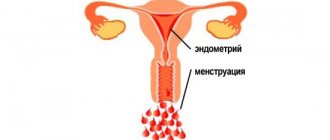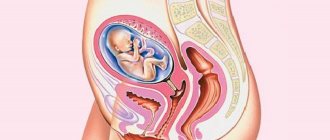Cases of fetal death are not uncommon these days.
The older a woman gets, the greater the risk of this pathology. But this does not mean that a 20-year-old girl’s fetus cannot freeze.
There are many other factors influencing intrauterine embryo death.
Therefore, it is important to know how to determine a frozen pregnancy at home in order to avoid such sad consequences as intoxication of the female body and even death.
Causes of non-developing pregnancy
The fetus can freeze as a result of the mother’s poor lifestyle or due to various diseases:
- drinking alcohol, smoking;
- independent use of medications without a doctor’s prescription;
- infectious diseases, for example, rubella, influenza, cytomegalovirus;
- constant stress, overexertion;
- lifting weights;
- hormonal imbalance;
- work in hazardous industries, etc.
Frozen pregnancy
Why does pregnancy stop?
The mechanisms of this phenomenon are not fully understood; the causes of missed abortion are different and often complex. To understand why a frozen pregnancy occurs, you need to talk in more detail about the main factors leading to intrauterine fetal death:
- Complex genetic combinations sometimes form an unfortunate picture, resulting in a non-viable fetus. Chromosomal abnormalities and developmental defects are the most common causes of missed abortion in the early stages. The fetus is most often rejected by the body on its own; for a woman it can look like normal menstruation, sometimes she never finds out that she was pregnant.
- The immune system of a pregnant woman is vulnerable to various diseases due to the fact that the body specifically suppresses protective functions so that the uterus does not reject a body that is foreign to it - the fertilized egg. As a result, the infection can penetrate the membranes, leading to infection of the fetus. Even a common ARVI in rare cases can lead to dire consequences
- Hormonal imbalance. A lack of the female hormone progesterone or an excess of male androgens are the causes of missed abortion in the first trimester. To prevent this, based on the test results, you need to agree with your doctor on maintenance hormonal therapy, which usually lasts up to 14 weeks.
- Wrong lifestyle. It would seem that the ban on smoking and alcohol during pregnancy is obvious, but pregnancy is not always a long-awaited and planned gift. Toxic substances impair blood circulation and block the flow of oxygen and nutrients to the embryo. Poor nutrition and lack of walks in the fresh air also have a detrimental effect on the fetus.
- Antiphospholipid syndrome (APS) is another common cause of pregnancy failure. This is an autoimmune disorder that causes blood clots to form in large veins. APS is the cause of 5% of missed abortions.

Methods for determining a non-developing pregnancy
Of course, the best way to diagnose pathology is ultrasound..
But what to do when it is not possible to urgently come to the hospital, for example, a woman has gone to the village, and there are no diagnostic devices there? How then to recognize a frozen pregnancy in order to take appropriate measures in time?
For this, knowledge of the clinical signs of miscarriage will help. A frozen pregnancy can be determined by its characteristic signs.
Thus, pathological symptoms are divided into 2 groups depending on the timing of pregnancy:
- Signs characteristic of fetal freezing in the early stages.
- Signs by which one can judge the death of the fetus in the later stages.
Treatment of frozen pregnancy
In the early stages of fetal death, medical abortion is used. If the fetus has frozen in the last stages of pregnancy, then labor is stimulated to induce the birth of a child. If it is too early to induce labor, and the size of the fetus does not allow the use of medical abortion, then curettage is used.
During a frozen pregnancy, it is important to undergo postoperative treatment. The doctor prescribes medications that will help the body recover and eliminate inflammatory processes if they appear.
After a frozen pregnancy, a full examination is required. This is necessary to determine the causes of fading and eliminate them in the future. Also, after pregnancy fading, histology is carried out, that is, the study of a smear and section of the uterus.
Signs of a frozen pregnancy in the first trimester
Basal temperature during frozen pregnancy
When pregnancy occurs and throughout all three trimesters, a woman's temperature in the rectum increases.
If a woman measured her temperature at the time of pregnancy and after suspecting a frozen pregnancy, and it became lower, then this may be a sign of fetal fading.
Basal temperature during pregnancy increases by 1–2 degrees.
A sharp decrease in basal temperature (measured in the rectum) may indicate a frozen pregnancy.
A decrease in temperature occurs due to the cessation of the corpus luteum performing its functions, as a result of which the level of progesterone drops sharply.
However, you should not rely only on this sign. There are cases when, even with a non-developing pregnancy, a woman’s basal temperature is above normal.
As a result, the woman thinks that her pregnancy is going well, but in fact she has no idea that she is carrying a dead child under her heart.
Abrupt disappearance of toxicosis symptoms
One of the signs of a frozen pregnancy in the early stages is a decrease or disappearance of toxicosis. For example, a woman felt sick every morning, and then suddenly everything stopped.
Pain during frozen pregnancy
With any pathology, including non-development of the fetus, pain can be observed. When the embryo freezes, the pain is cramping . They start in the lower abdomen and reach the lower back.
Vaginal discharge
Watery, bloody, bloody discharge in a pregnant woman is an alarm bell . This is the first sign that you need to sound the alarm.
If the discharge is curdled or transparent, then this phenomenon is not dangerous and does not indicate the death of the fetus.
Changes in the mammary glands
During pathology, the breasts begin to become rough, and the woman may experience pain.
Although in some situations the opposite happens: the woman’s mammary glands were sensitive, and when the embryo freezes, the unpleasant sensations go away.
This is due to the fact that when the fetus dies, the breasts completely relax and hormonal processes are disrupted.
Symptoms of a frozen pregnancy can be either single or multiple.
Urination
During pregnancy, women experience frequent urination. If it is restored, the pregnant woman stops frequently running to the toilet, then this may be an indirect sign of a frozen pregnancy.
How to determine a frozen pregnancy in the early stages?
Some people feel pregnancy from the first days, for others it is a surprise until the first movements. But both categories fall into the risk group for the possibility of embryonic death.
The only difference is that a woman who has realized her special situation in the first weeks will be able to determine the pathology herself (by sensation or in a antenatal clinic for an ultrasound). The other one will most likely go to the doctor if she feels unwell, and both diagnoses will be a complete surprise to her.
Let's focus on the first category of expectant mothers.
From the first days she knew that she was pregnant, her gastronomic tastes had changed somewhat, her favorite perfume caused nausea and headaches. My breasts have become very sensitive, I constantly want to sleep, and my husband and boss have become downright annoying. This condition lasted for 2-3 weeks and suddenly disappeared. The key word is suddenly ! Before this, there could be a low temperature (37-37.5C), general malaise, heaviness in the lower abdomen, and spotting.
If you urgently consult a doctor, a frozen pregnancy can be diagnosed immediately (if the expected gestational age is more than 6 weeks and a heartbeat has previously been heard on the device).
The woman knew that she was pregnant, the toxicosis was more than obvious. After some time, signs of a cold ; nausea, drowsiness and fatigue disappeared, my health improved. A few weeks later (up to 4-5), spotting (not scarlet, but dark brown, with clots). An ultrasound examination diagnoses a frozen pregnancy. That is, the embryo died several weeks ago, the body reacted to this with fever, but began to reject it much later.
Symptoms of frozen pregnancy in the 2nd and 3rd trimester
Lack of fetal development and death in the third trimester is a very dangerous phenomenon. If trouble is not detected in a timely manner, the woman may not survive.
Therefore, every girl should know how a frozen pregnancy manifests itself in the later stages:
- Lack of fetal activity - it stops moving.
- The uterus does not increase in size.
- The belly stops growing.
- The mammary glands decrease in size. The tension in them disappears, they become soft, just like before pregnancy.
- Increased body temperature . If a pregnant woman does not suspect that the fetus has frozen and continues to carry a dead child, then an infection begins to develop in her uterus. This causes an increase in body temperature.
If a woman is in the 3rd trimester of pregnancy and within 2 days she stops feeling the movement of the fetus, then she urgently needs to run to the doctor.
Pathology in the second trimester
It would seem that we have survived the first 12 weeks; nothing else should threaten the child. Well, at least you can quickly react to danger. But, unfortunately, cases of fetal death in the second trimester of pregnancy are not at all uncommon.
The first unconditional symptom of pathology is the absence of the baby's movements . But! The baby pushes very softly and gently and this is felt mainly in the lying position. Therefore, those women who are constantly on the move may not immediately notice suspicious silence. Moreover, consult a doctor about this.
The next important aspect is the results of ultrasound . This is the most reliable option for determining the baby’s viability.
The size of the fetus, blood circulation in the uterus and placenta, the development of internal organs - all this must correspond to the term. Otherwise, the pregnancy may be considered pathological or frozen.
And the final symptom, in the presence of those already listed, will be spotting . This means the body begins to reject the placenta or the fetus itself.
What to do if a pathology is detected
The 20th week is half of the entire pregnancy. Of course, at this time it will not be possible to hide the signs of a special condition, and the woman herself feels unity with the baby, who is growing every day and delights with new achievements. However, the only correct option for the pathology of freezing is abortion.
Termination of pregnancy is always performed in a hospital under the close supervision of doctors. At 20-23 weeks, doctors prescribe artificial birth.
Almost 80% of women who experienced fading in later stages face miscarriage phobias in the future.
The recovery process in this case is protracted, the patient’s emotional state is extremely difficult. Professional support from psychologists and, of course, relatives is often required. It is extremely important to undergo rehabilitation and treatment that will help avoid future tragedy.
Frozen pregnancy at 20-23 weeks of pregnancy: diagnosis, causes and alarming symptoms
The period of 20-23 weeks can be considered a kind of milestone, because by this time half the journey has been “traversed”, which means that all the main processes and organs of the baby inside the womb are half formed.
However, even at such a late stage, something irreparable can happen - the death of the fetus.
In order to recognize a frozen pregnancy in time, you must carefully study its symptoms and immediately report the slightest suspicion to your doctor.
Exposure to negative factors in the form of stressful situations, accidents, shocks, disorders of the thyroid gland or other endocrine diseases can cause a stop in the development of the fetus in the later stages. The percentage of such pathologies in the period 20-23 weeks is quite small: one in 1000. However, a frozen pregnancy is a huge stress, which not every woman can fully cope with.
The risk of developing freezing pathology after the 20th week increases by 30% if a woman takes a large number of medications without a doctor’s prescription. Particularly dangerous are Analgin, Griseofulvin, Biseptol, Bactrim, Warfarin, Amitriptyline.
If in the early stages a woman cannot personally and accurately identify problems in the development of the baby, then in the period from the 20th week alarming symptoms will not go unnoticed. Often negative changes are accompanied by bloody discharge, uterine spasms, and contractions. The placenta is rejected.
Signs at 20-23 weeks
At the 20th week, the first movements of the fetus are observed, and the woman herself feels its movements and tremors. Visual changes also occur: the uterus at this stage is at the level of the navel, the stomach is visible to the naked eye. The fruit itself is so large that it makes itself felt with sharp jolts. Signs of the development of pathologies are primarily associated with these symptoms of pregnancy.
How do the first symptoms appear?
The first signs of developmental anomalies or peculiar “alarm bells” are associated with the lack of fetal movement. You should also pay attention to the following symptoms:
- headache as a manifestation of intoxication;
- hard belly for several hours (uterine tone);
- cramps and pain in the lower abdomen;
- nausea, vomiting in the absence of toxicosis symptoms;
- spotting, a mixture of mucus and blood veins, brown mucous discharge - signs of rejection;
- zero activity of the baby for three or more days;
- softening of the mammary glands, reducing nipple sensitivity.
Such symptoms are individual, and each pregnant woman can observe sluggish symptoms in the first days. However, the rejection process at this stage is almost always accompanied by red or brown discharge.
At 20 weeks
A child at 20 weeks of pregnancy is no longer an embryo, which only partially resembles a human in appearance, but a 25-centimeter baby with a formed heart, kidneys and nervous system.
During this period, eyelashes are formed, and the skin is covered with a special fatty lubricant. However, there are still many processes ahead for the development of systems and organs.
But, if there are reasons why fading occurs, then the following is observed:
- decreased activity of the fetus inside the womb, and then a complete stop of movements;
- decreased nipple sensitivity;
- aching pain in the lower back;
- headache.
At 21 weeks
At week 21, the fetus does not move, the heartbeat cannot be heard, and the pregnant woman has the following symptoms:
- brown discharge streaked with scarlet blood and mucus;
- removal of the plug from the cervical canal;
- uterine tone (stony and very tight abdomen);
- change in the shape of the abdomen (possible prolapse);
- headache.
At 22 weeks
Until week 22, the fetus is actively developing. Almost all the reasons why it fades are associated with autoimmune diseases of the mother, genetic diseases, and toxic substances that have entered the body. A pregnant woman may observe:
- copious discharge;
- discharge of mucus from the vagina (congestion);
- headache;
- pain in the lower back, abdomen;
- nagging pain in the navel area;
- lack of fetal movements;
- increase in vaginal discharge.
At 23 weeks
Symptoms at later stages are represented by the following signs:
- abdominal pain;
- cramps in the uterus;
- increasing intensity of bleeding.
If the cause of this condition is hormonal, then a decision is made to use hormone replacement therapy. The main thing is to find out the cause and establish the condition of the fetus.
The pathogenesis of the fading of processes in the development of a baby is associated with multiple factors, which may differ in intensity and aggression.
- Antiphospholipid syndrome – 40% of late freezing cases. This is a condition in which the mother’s body rejects a foreign body (a child is always a foreign body for the uterus).
- Hormones – 20%. A decrease in the concentration of prolactin, which is replaced by the male hormone testosterone.
- Infections, virus (herpes, rubella, chickenpox, FLU) – 20%.
- Chromosomal defects - 10%, provided that before this period the body, if there are abnormalities, rejects the fetus. If the baby develops after 20 weeks, it means that no genetic defects were found.
- Antisocial lifestyle – 5% of all deaths. A child may be born with anomalies, with a “bouquet” of diseases, but freezing occurs for this reason extremely rarely.
- Other factors (unknown pathologies, environmental influences, stress, individual characteristics of the body) – 5%.
The period starting from the 20th week is critical, after which we can talk about the presence of pathologies of organ development. Screening diagnostics are carried out from 21 to 22 weeks to identify abnormalities in the development of the heart, brain, kidneys, and liver.
How to diagnose
Diagnosis in the presence of a frozen pregnancy at such a late stage comes down to research:
- HCG determines the concentration of human chorionic gonadotropin in the blood, after which the data obtained is compared with the period of gestation;
- An ultrasound, which, in fact, will show that the heart has stopped beating.










